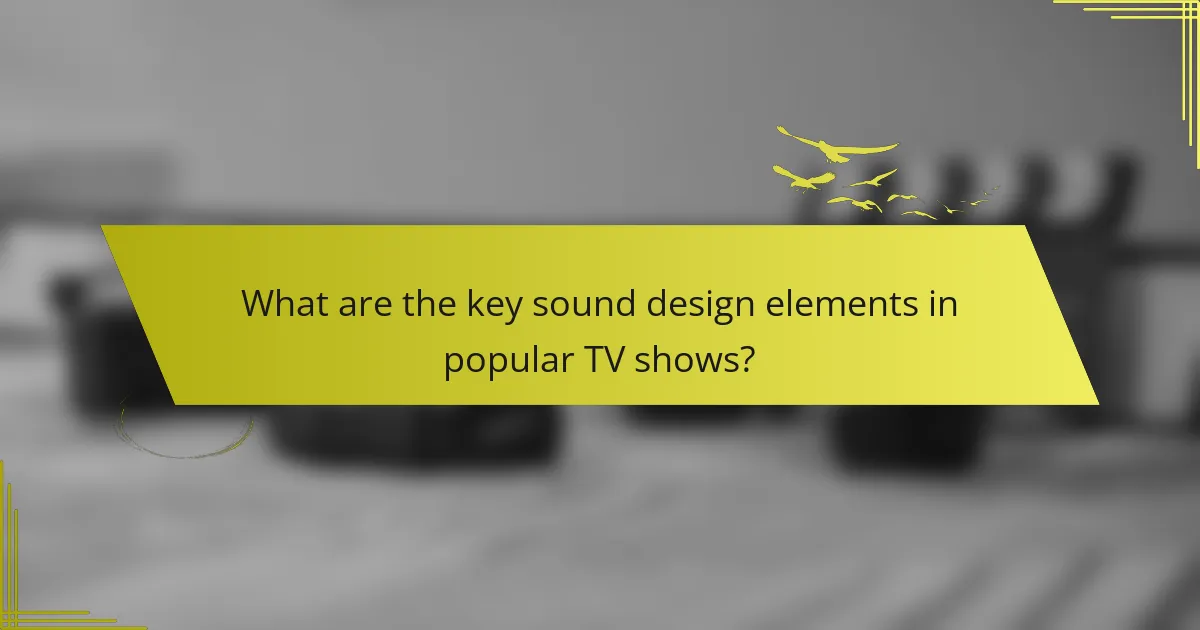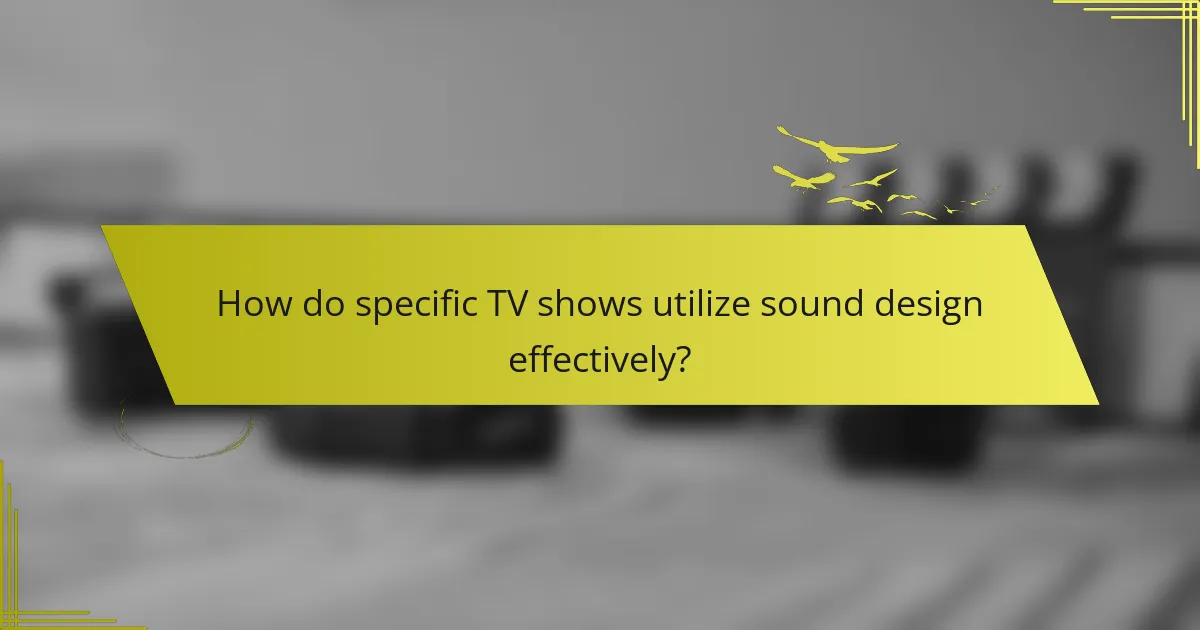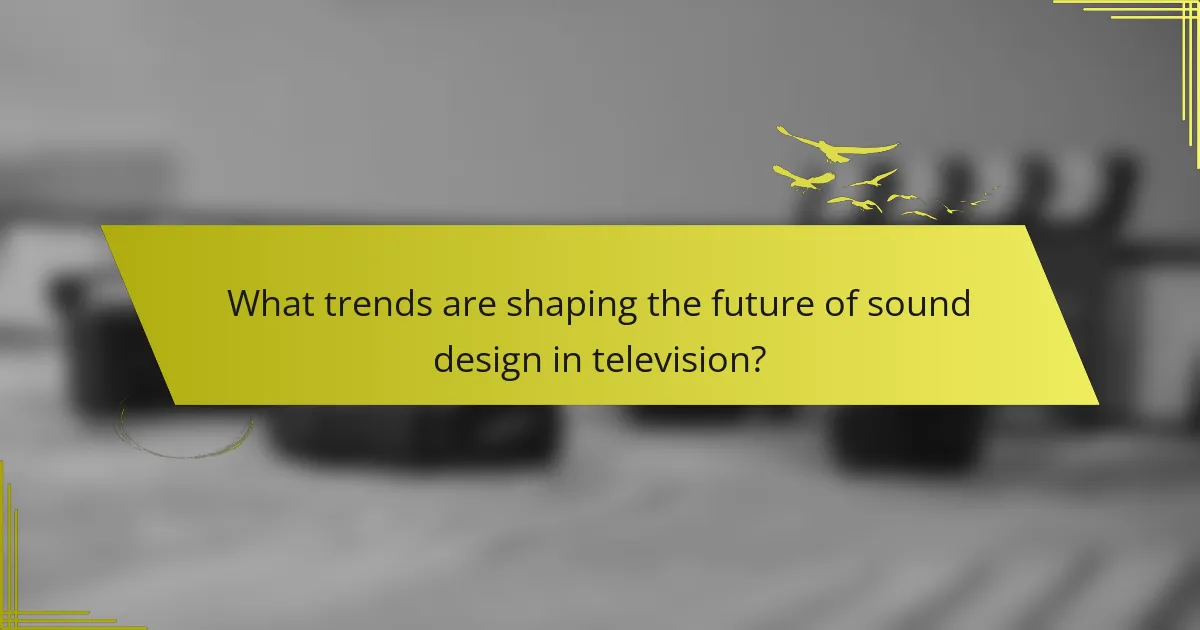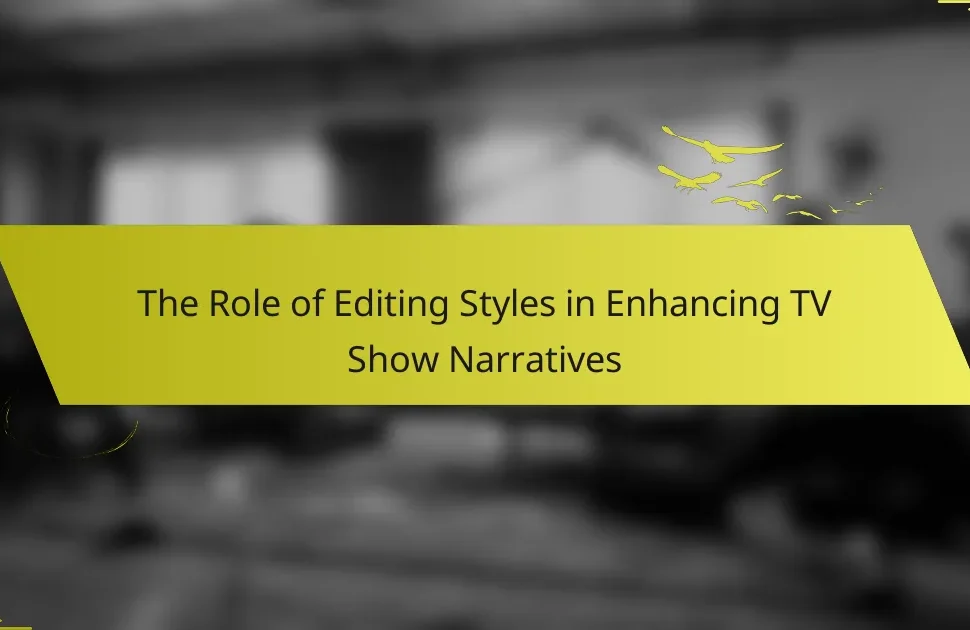Sound design elements in popular TV shows include dialogue, sound effects, music, and ambient sound, all of which contribute to storytelling and viewer engagement. Dialogue aids character development, while sound effects enhance realism and emotional impact. Music sets the tone for scenes, becoming iconic in series like “Stranger Things” and “Game of Thrones,” where specific sound choices reinforce themes and heighten emotional resonance. Trends in sound design are evolving with immersive soundscapes, adaptive audio technology, and spatial audio, reflecting a shift towards more personalized auditory experiences in television. These advancements indicate a growing emphasis on the role of sound in enhancing the overall viewing experience.

What are the key sound design elements in popular TV shows?
Key sound design elements in popular TV shows include dialogue, sound effects, music, and ambient sound. Dialogue is crucial for character development and plot progression. Sound effects enhance realism and create emotional impact. Music sets the tone and mood for scenes, often becoming iconic. Ambient sound contributes to the overall atmosphere, immersing viewers in the show’s world. These elements work together to create a cohesive auditory experience that supports storytelling. For example, shows like “Stranger Things” utilize synthesizer music to evoke nostalgia and tension.
How do sound design elements enhance storytelling in television?
Sound design elements significantly enhance storytelling in television by creating emotional depth and atmosphere. They provide auditory cues that guide viewer reactions. For example, a suspenseful score builds tension during critical scenes. Ambient sounds establish the setting and immerse the audience in the story world. Dialogue clarity ensures that character interactions are understood. Sound effects add realism, making actions more impactful. Research by the University of Southern California highlights how sound influences emotional responses in visual media. This demonstrates that effective sound design is crucial for narrative engagement.
What role does sound play in character development within TV shows?
Sound plays a crucial role in character development within TV shows. It enhances emotional depth and provides insight into a character’s personality. For example, a character’s theme music can reflect their inner struggles or triumphs. Sound effects can signify a character’s presence or absence, influencing audience perception. Dialogue delivery, including tone and pace, reveals motivations and relationships. Background sounds can establish context, shaping how viewers interpret character actions. Research indicates that sound design significantly impacts viewer engagement and emotional response, reinforcing character arcs. Overall, sound serves as a vital tool for storytelling and character exploration in television.
How does sound design influence audience emotions and reactions?
Sound design significantly influences audience emotions and reactions by creating an immersive experience. It utilizes elements like music, sound effects, and silence to evoke specific feelings. For example, suspenseful music can heighten tension during a dramatic scene. Conversely, uplifting melodies may generate feelings of joy or relief. Research indicates that sound can trigger emotional responses faster than visuals alone. According to a study published in the Journal of Experimental Psychology, sound design can enhance memory recall and emotional engagement in viewers. This underscores its vital role in storytelling within popular TV shows.
What types of sound design elements are commonly used in TV shows?
Common sound design elements in TV shows include dialogue, sound effects, music, and ambient sounds. Dialogue is crucial for character interaction and storytelling. Sound effects enhance actions and events, adding realism. Music sets the emotional tone and can signal transitions. Ambient sounds create a sense of place and atmosphere. These elements work together to engage viewers and support narrative development. Studies show that effective sound design significantly impacts audience immersion and emotional response.
What are the differences between diegetic and non-diegetic sounds?
Diegetic sounds are sounds that originate from within the story world. They can be heard by the characters and contribute to the narrative. Examples include dialogue, footsteps, and ambient noise. Non-diegetic sounds, on the other hand, come from outside the story world. These sounds are not heard by the characters and often serve to enhance the audience’s experience. Examples include background music and voiceovers. The distinction between these two types of sounds is crucial in sound design. Understanding this difference helps in analyzing how sound influences storytelling in popular TV shows.
How do sound effects contribute to the overall viewing experience?
Sound effects enhance the overall viewing experience by creating an immersive atmosphere. They help convey emotions and set the tone of scenes. For example, suspenseful sounds can heighten tension during critical moments. Research indicates that sound effects can increase viewer engagement and retention. A study by the University of Southern California found that sound design significantly impacts audience perception and emotional response. Effective sound effects can also guide viewers’ attention to key visual elements. This interplay between audio and visual components enriches storytelling and enhances narrative impact.

How do specific TV shows utilize sound design effectively?
Specific TV shows utilize sound design effectively to enhance storytelling and viewer engagement. For example, “Stranger Things” employs an 80s synth score to evoke nostalgia. This sound design choice reinforces the show’s setting and themes. Similarly, “Game of Thrones” uses orchestral music to heighten emotional impact during pivotal scenes. The sound design in this series builds tension and underscores character development. “The Walking Dead” incorporates environmental sounds to create a sense of realism and foreboding. This approach immerses viewers in the post-apocalyptic world. Additionally, “Breaking Bad” features unique sound motifs that signal character transformations. These auditory cues deepen the narrative experience. Overall, effective sound design in these shows enhances emotional resonance and audience connection.
What notable examples of sound design can be found in critically acclaimed TV shows?
Notable examples of sound design in critically acclaimed TV shows include “Game of Thrones,” “Stranger Things,” and “Breaking Bad.” In “Game of Thrones,” the sound design enhances the epic battles and emotional moments. The use of ambient sounds creates an immersive experience for viewers. “Stranger Things” features a nostalgic synth-heavy score that complements its 1980s setting. The sound effects, like the Demogorgon’s growl, are pivotal to the show’s suspense. “Breaking Bad” employs sound to underscore character development and tension. The use of silence and specific sound cues amplifies critical scenes. Each show demonstrates how sound design significantly contributes to storytelling and audience engagement.
How does the sound design in “Stranger Things” create a nostalgic atmosphere?
The sound design in “Stranger Things” creates a nostalgic atmosphere by utilizing synth-heavy music and sound effects reminiscent of the 1980s. This choice evokes memories of classic films and video games from that era. The series employs a mix of ambient sounds and eerie tones to enhance suspense. Iconic synth melodies, similar to those used by composers like John Carpenter, are prevalent throughout. These musical elements trigger emotional responses tied to viewers’ past experiences. Additionally, the sound design incorporates retro audio effects, such as vinyl crackles and tape hiss. This further immerses the audience in a familiar auditory landscape. Overall, the sound design effectively transports viewers back to the 1980s, reinforcing the show’s nostalgic theme.
What techniques are used in “Game of Thrones” to enhance epic battle scenes?
“Game of Thrones” employs various techniques to enhance epic battle scenes. These techniques include intricate choreography, realistic sound design, and strategic camera angles. Choreographed fight sequences create a sense of realism and intensity. The use of practical effects, such as real fire and physical props, adds authenticity to the battles. Sound design plays a crucial role, with layered audio effects amplifying the chaos of combat. The score, composed by Ramin Djawadi, elevates emotional stakes during key moments. Additionally, editing techniques, such as rapid cuts and slow motion, emphasize critical actions. The combination of these elements results in immersive and memorable battle sequences.
What challenges do sound designers face in TV production?
Sound designers in TV production face several challenges. One major challenge is achieving high-quality audio in various environments. This includes managing background noise and ensuring clarity in dialogue. Another challenge is the synchronization of sound effects with visual elements. This requires precise timing to enhance the viewer’s experience. Additionally, sound designers must work within tight deadlines. Quick turnaround times can limit creative exploration and experimentation. Budget constraints also pose challenges, affecting the resources available for sound design. Furthermore, collaboration with directors and other departments can lead to conflicting creative visions. These challenges require sound designers to be adaptable and resourceful in their craft.
How do budget constraints affect sound design choices?
Budget constraints significantly influence sound design choices in media production. Limited financial resources often lead to reduced access to high-quality sound equipment and professional sound designers. This can result in a reliance on stock sound libraries instead of custom sound effects. The use of cheaper, less sophisticated technology may compromise audio quality. Additionally, budget limitations can restrict the number of sound layers used in a scene, leading to simpler soundscapes. Productions may prioritize essential sounds over nuanced audio details due to cost. Consequently, the overall auditory experience may be less immersive and dynamic. Studies show that lower-budget productions often exhibit less innovative sound design compared to their higher-budget counterparts.
What are the technical challenges of synchronizing sound with visuals?
The technical challenges of synchronizing sound with visuals include latency issues, frame rate discrepancies, and audio-visual alignment. Latency occurs when there is a delay between audio playback and visual display, disrupting the intended synchronization. Frame rate discrepancies arise when the audio and visual components operate at different frame rates, causing mismatches in timing. Audio-visual alignment concerns the precise timing needed for sound effects and dialogue to match the corresponding visual actions. These challenges can lead to a disjointed viewing experience. Accurate synchronization is critical in media production to maintain immersion and narrative coherence.

What trends are shaping the future of sound design in television?
Trends shaping the future of sound design in television include immersive soundscapes, adaptive audio technology, and increased use of spatial audio. Immersive soundscapes enhance viewer experience by creating a more engaging environment. Adaptive audio technology allows sound to change based on viewer interaction or scene dynamics. Spatial audio, which provides a three-dimensional sound experience, is becoming more prevalent. The rise of streaming services has also influenced sound design, leading to higher production values. Furthermore, advancements in sound editing software improve efficiency and creativity in sound design. These trends indicate a shift towards more personalized and impactful auditory experiences in television.
How is technology influencing sound design practices in TV shows?
Technology is significantly influencing sound design practices in TV shows. Advanced software tools enable sound designers to create intricate soundscapes. Digital audio workstations (DAWs) allow for precise editing and manipulation of audio tracks. High-definition audio formats enhance the clarity and depth of sound. Surround sound technology immerses viewers in a multi-dimensional auditory experience. Automated sound mixing and mastering streamline production workflows. The use of plugins and virtual instruments expands creative possibilities. Real-time sound processing enhances live broadcasts and performances. These technological advancements improve the overall quality and impact of sound design in television.
What emerging tools and software are revolutionizing sound design?
Emerging tools and software revolutionizing sound design include AI-driven platforms, spatial audio technologies, and advanced synthesis tools. AI-driven platforms like LANDR and AIVA automate mixing and mastering processes. These tools enhance efficiency and accessibility for sound designers. Spatial audio technologies, such as Dolby Atmos and Apple Spatial Audio, create immersive sound experiences. They provide dynamic sound placement in three-dimensional space. Advanced synthesis tools like Serum and Omnisphere offer unique sound creation capabilities. These tools enable designers to craft intricate soundscapes. Together, these innovations are reshaping the landscape of sound design in various media, including popular TV shows.
How does virtual reality impact sound design in television?
Virtual reality significantly alters sound design in television by creating immersive audio experiences. It allows sound designers to place sounds in a 3D space, enhancing realism. This spatial audio can adapt to viewer movements, making sound more dynamic. Traditional sound design often uses stereo or surround sound, which lacks this level of interaction. In VR, sounds can change based on the viewer’s perspective, leading to a more engaging narrative. Research shows that immersive audio increases audience engagement and emotional response. Studies indicate that viewers report higher satisfaction levels when sound design incorporates VR elements.
What best practices should aspiring sound designers follow?
Aspiring sound designers should focus on continuous learning and practice. They must familiarize themselves with industry-standard software and hardware. Understanding sound theory and acoustics is crucial for effective design. Collaboration with other creatives enhances their skill set and perspective. Regularly analyzing sound design in popular TV shows provides valuable insights. Networking within the industry can lead to mentorship and job opportunities. Seeking feedback on their work helps refine their techniques. Staying updated on trends and technologies ensures relevance in a competitive field.
How can sound designers effectively collaborate with other departments?
Sound designers can effectively collaborate with other departments by establishing clear communication channels. Regular meetings ensure all teams are aligned on project goals. Using collaborative software can streamline feedback and revisions. Sound designers should actively participate in brainstorming sessions with writers and directors. This involvement fosters a shared vision for the project. Sharing audio samples early helps visualize the sound design concepts. Additionally, understanding the needs of other departments enhances the integration of sound elements. For example, knowing the visual style can inform sound choices. These practices lead to a cohesive final product that meets the creative vision.
What are some common pitfalls to avoid in sound design for TV shows?
Common pitfalls to avoid in sound design for TV shows include neglecting dialogue clarity. Poor mixing can make dialogue difficult to understand. Another pitfall is overusing sound effects, which can distract from the narrative. Inconsistent audio levels can also disrupt viewer experience. Failing to match sound design with the emotional tone of scenes can weaken storytelling. Additionally, overlooking the importance of ambient sound can create a lifeless atmosphere. Lastly, not considering the audience’s listening environment can lead to subpar audio experiences. These pitfalls can significantly impact the overall quality of the show.
The main entity of the article is sound design elements in popular TV shows. The article analyzes key components such as dialogue, sound effects, music, and ambient sound, highlighting their roles in enhancing storytelling and character development. It also explores the impact of sound design on audience emotions and reactions, differentiating between diegetic and non-diegetic sounds. Additionally, notable examples from acclaimed shows like “Stranger Things” and “Game of Thrones” illustrate effective sound design practices. The article addresses challenges faced by sound designers and discusses emerging trends and technologies shaping the future of sound design in television.




